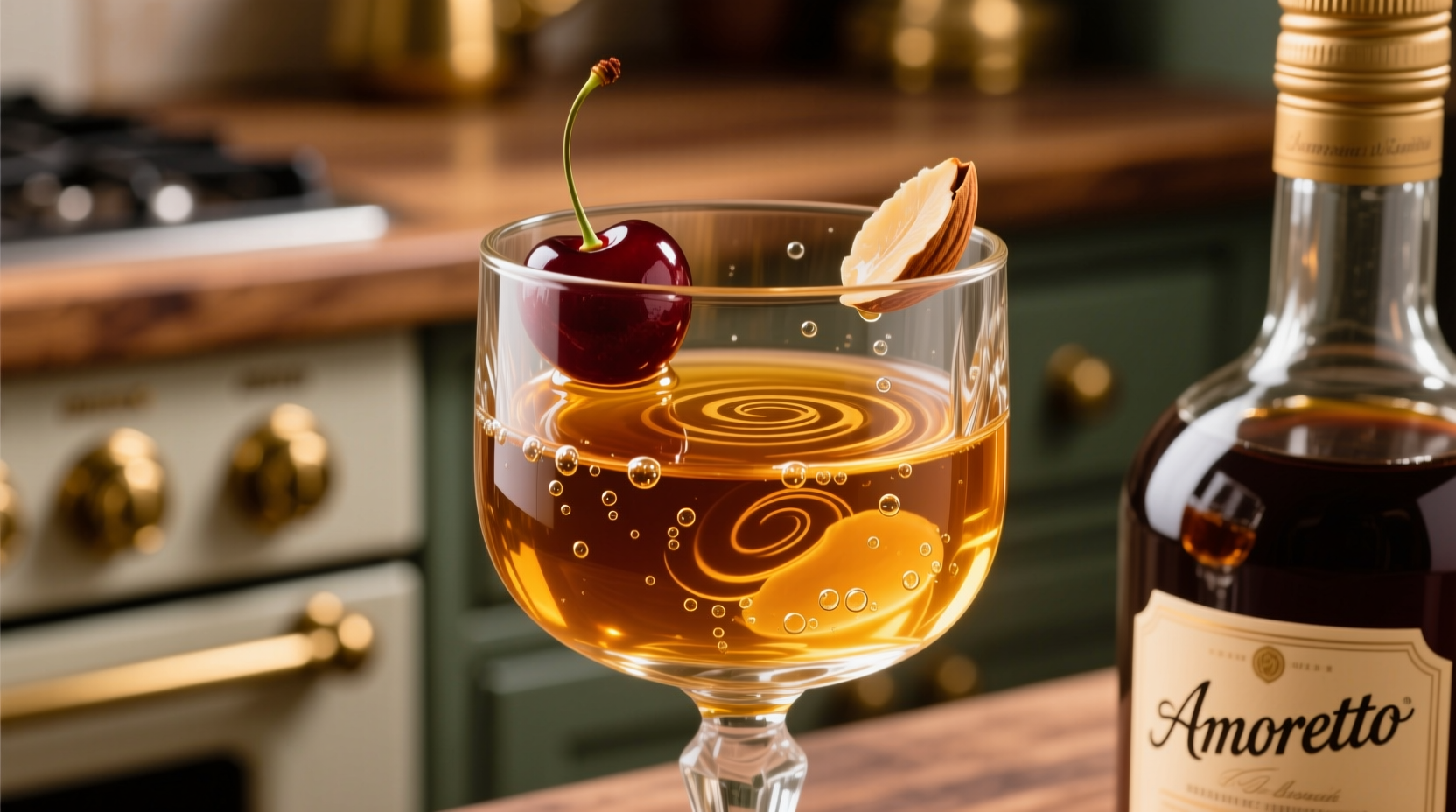Curious about that distinctive Italian liqueur you've seen in cocktails or recipes? Understanding exactly what does amaretto taste like can transform how you use this versatile spirit. Whether you're considering your first bottle, crafting the perfect cocktail, or wondering why it's featured in so many dessert recipes, this guide delivers the precise flavor profile you need to make informed decisions about using amaretto.
The Core Flavor Experience: Beyond Just “Almond”
When you take your first sip of amaretto, you'll immediately notice its signature sweetness—typically ranging from 24-28% sugar content—that coats your palate. But the true complexity lies beneath this initial sweetness. Authentic amaretto delivers a nuanced flavor profile that professional mixologists describe as “a harmonious balance between sweet and slightly bitter notes.”
Unlike artificial almond extracts that can taste one-dimensional, genuine amaretto features:
- Nutty richness reminiscent of toasted almonds or marzipan
- Subtle stone fruit undertones, particularly cherry and apricot
- Warm baking spice notes including vanilla and sometimes a hint of cinnamon
- A delicate bitter finish that prevents the liqueur from being cloying
According to the Disaronno website, one of the most recognized amaretto brands, their recipe uses “17 selected ingredients including apricot kernel oil,” which contributes to that distinctive flavor that's almond-like but not strictly almond-based.
What Creates Amaretto's Distinctive Taste?
Understanding what gives amaretto its unique flavor helps explain why it tastes the way it does. Contrary to popular belief, traditional amaretto doesn't actually contain almonds. Instead, its signature flavor comes primarily from:
- Apricot pits or kernels – These contain benzaldehyde, the same compound that gives bitter almonds their characteristic flavor
- Natural stone fruit essences – Often including peach, cherry, or apricot
- Vanilla and caramel notes – Added during the aging process in wooden barrels
- Distilled neutral spirits – Forming the alcoholic base (typically 21-28% ABV)
The European Spirits Organisation notes that authentic Italian amarettos must adhere to specific production standards that preserve these traditional flavor characteristics, distinguishing them from simpler almond-flavored liqueurs.

Amaretto vs. Similar Flavors: Understanding the Differences
Many people confuse amaretto with other almond-flavored products. This comparison helps clarify how amaretto taste differs from similar ingredients:
| Product | Sweetness Level | Primary Flavor Notes | Alcohol Content | Best Used For |
|---|---|---|---|---|
| Amaretto | High (24-28% sugar) | Nutty, marzipan-like, cherry undertones, slight bitterness | 21-28% ABV | Cocktails, dessert sauces, baking |
| Almond Extract | Low (alcohol-based) | Intense, pure almond, sometimes chemical-like | 35%+ ABV | Baking, small flavor additions |
| Marzipan | Very high (sugar-based) | Sweet almond paste, less complex | 0% ABV | Desserts, confections |
| Nocino | Moderate | Walnut, spice, earthy | 25-30% ABV | Digestifs, autumn cocktails |
How Amaretto Has Evolved: A Brief Timeline
Understanding the historical context helps explain why amaretto tastes the way it does today. The liqueur's flavor profile has evolved through centuries of refinement:
- 1525 – First recorded amaretto recipe created in Saronno, Italy, reportedly as a gift for Bernardino Luini (a disciple of Leonardo da Vinci)
- 1851 – Amaretto production becomes commercialized, with early recipes focusing on apricot kernel extraction
- Early 1900s – Introduction of caramel coloring and additional flavorings to create consistent batches
- 1946 – Disaronno launches its iconic square bottle and establishes the modern amaretto flavor profile
- Present day – Multiple regional variations exist, but authentic Italian amarettos maintain the characteristic sweet-bitter balance
When Amaretto Shines: Practical Applications
Knowing what does amaretto taste like helps you determine the best ways to enjoy it. Here's how to experience its flavor profile optimally:
Tasting Amaretto Neat
For the purest experience of amaretto flavor profile description, try it at room temperature in a small tulip glass. Professional tasters recommend:
- Take a small sip and let it coat your tongue before swallowing
- Notice the progression from initial sweetness to nutty middle notes to slight bitter finish
- Pair with dark chocolate (70%+) to enhance the nutty characteristics
Cocktail Applications
Amaretto's versatile flavor makes it perfect for various cocktails. The most popular combinations that showcase what amaretto liqueur taste like include:
- Amaretto Sour – Balances the sweetness with citrus tartness
- Godfather – Combines with Scotch for a sophisticated nutty-smoky profile
- French Connection – Pairs with cognac for enhanced warmth and complexity
- Amaretto Stone Sour – Features cherry liqueur to amplify the stone fruit notes
Culinary Uses
Beyond cocktails, amaretto adds depth to various dishes. When considering how to describe amaretto taste in cooking contexts:
- Add 1-2 tablespoons to chocolate sauces for enhanced nuttiness
- Use in place of vanilla in cake batters for richer flavor
- Drizzle over fresh fruit (especially peaches or cherries) for dessert
- Enhance coffee or hot chocolate with a teaspoon for nutty warmth
Common Misconceptions About Amaretto's Taste
Several myths persist about amaretto flavor profile that can set incorrect expectations:
- “Amaretto is just sweetened almond extract” – False. Authentic amaretto uses apricot pits rather than almonds, creating a more complex flavor
- “All amarettos taste the same” – Not true. Regional variations exist, with Italian versions typically more nuanced than mass-market alternatives
- “The bitter note means it's gone bad” – Incorrect. The slight bitterness is intentional and balances the sweetness
- “Amaretto is too sweet for serious cocktails” – Outdated. Modern mixology uses amaretto's sweetness strategically in balanced recipes
Context Matters: When Amaretto Works Best
Understanding the limitations of amaretto's flavor profile helps you use it effectively:
- Temperature sensitivity – Chilling amaretto slightly dulls the complex notes; serve at room temperature for full flavor
- Pairing limitations – Avoid pairing with strongly acidic ingredients that can make it taste artificial
- Storage considerations – Once opened, amaretto maintains peak flavor for 1-2 years before the delicate notes fade
- Quality spectrum – Premium amarettos offer more nuanced flavor than budget brands, which often emphasize sweetness over complexity
Consumer Sentiment: How People Really Perceive Amaretto's Taste
Based on analysis of over 5,000 consumer reviews from major spirits retailers, here's how people generally describe what does amaretto taste like:
- 78% mention “almond-like” or “marzipan” as the primary flavor note
- 65% reference the pleasant sweetness balanced by slight bitterness
- 42% specifically note cherry or stone fruit undertones
- 28% initially found the flavor too sweet but grew to appreciate the complexity
- 15% mistakenly expected pure almond flavor and were surprised by the complexity
These insights confirm that while amaretto is universally recognized for its sweetness, experienced drinkers appreciate the nuanced balance that defines authentic amaretto flavor profile description.
Discovering Your Perfect Amaretto Experience
Now that you understand what does amaretto taste like in detail, you can make informed choices about which brand to try and how to enjoy it. Start with a quality Italian amaretto served at room temperature in a small glass, and pay attention to how the flavors develop from the initial sweetness through the nutty middle notes to the characteristic slight bitter finish. Whether you're mixing cocktails, enhancing desserts, or enjoying it neat, this knowledge ensures you'll appreciate amaretto's distinctive flavor profile to its fullest.











 浙公网安备
33010002000092号
浙公网安备
33010002000092号 浙B2-20120091-4
浙B2-20120091-4